Evidence-Based Practice for Needle Stick Injury Reduction
VerifiedAdded on 2022/10/11
|8
|2214
|9
Report
AI Summary
This report examines the application of evidence-based practice (EBP) to reduce the incidence of needle stick injuries in healthcare settings. The introduction highlights EBP as a problem-solving approach to improve patient health outcomes and emphasizes its importance in healthcare. The report focuses on how EBP can be used to decrease needle stick injuries, which are common among healthcare workers. It outlines the five stages of EBP: asking questions (using the PICOT framework), gathering evidence, critically appraising evidence, integrating evidence with clinical expertise and patient preferences, and evaluating the results. The discussion section addresses the nature of needle stick injuries, their causes (improper disposal of needles), and their prevalence. The report references literature to support the use of EBP in delivering high-quality care, reducing costs, and improving outcomes. It also discusses the importance of following safety protocols, such as using safety-engineered devices and reporting injuries. The conclusion reiterates the effectiveness of EBP in improving patient outcomes and reducing needle stick injuries by applying the EBP steps to address the problem. The report emphasizes the importance of sharing experiences with other healthcare staff to improve treatment for needle stick injuries.
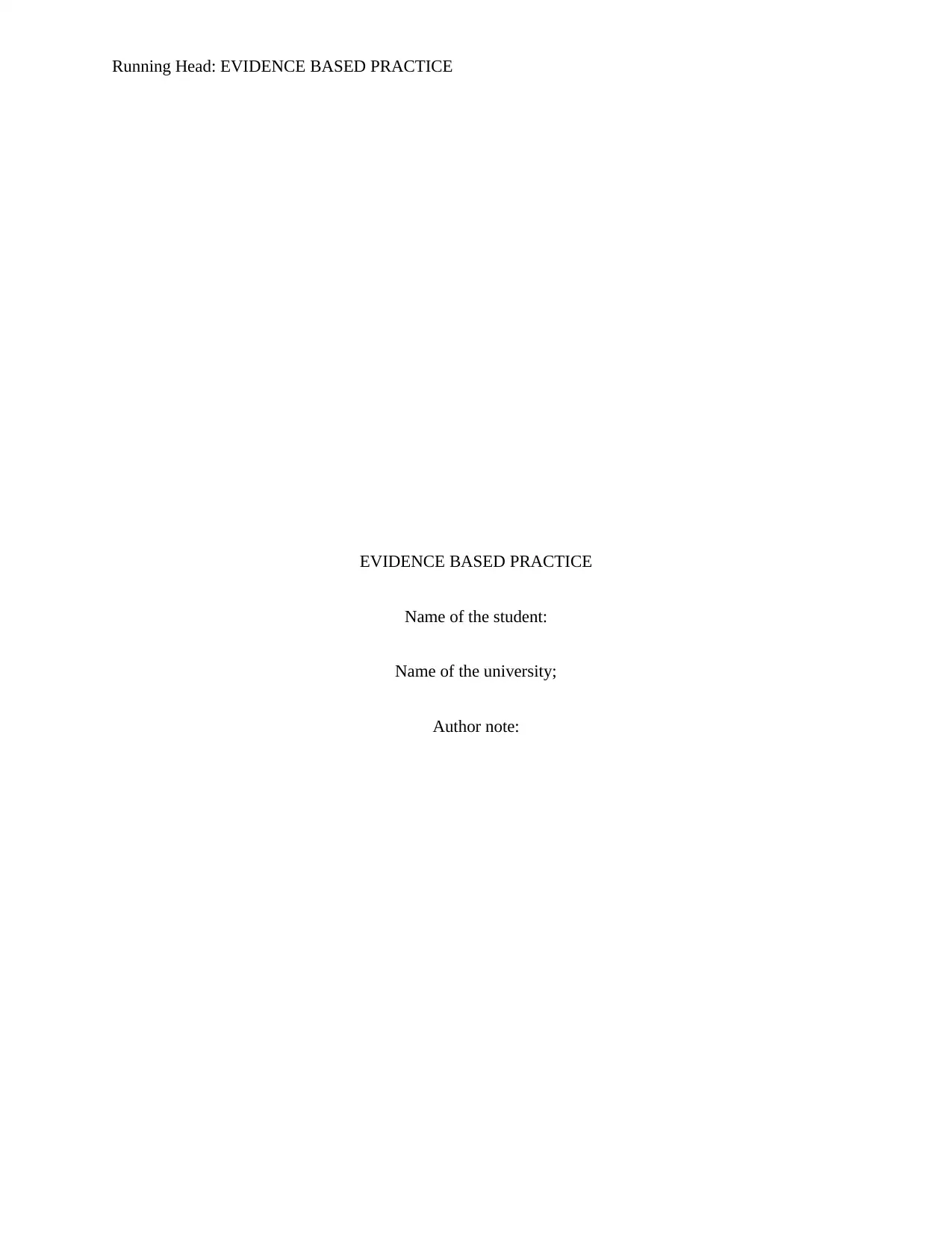
Running Head: EVIDENCE BASED PRACTICE
EVIDENCE BASED PRACTICE
Name of the student:
Name of the university;
Author note:
EVIDENCE BASED PRACTICE
Name of the student:
Name of the university;
Author note:
Paraphrase This Document
Need a fresh take? Get an instant paraphrase of this document with our AI Paraphraser
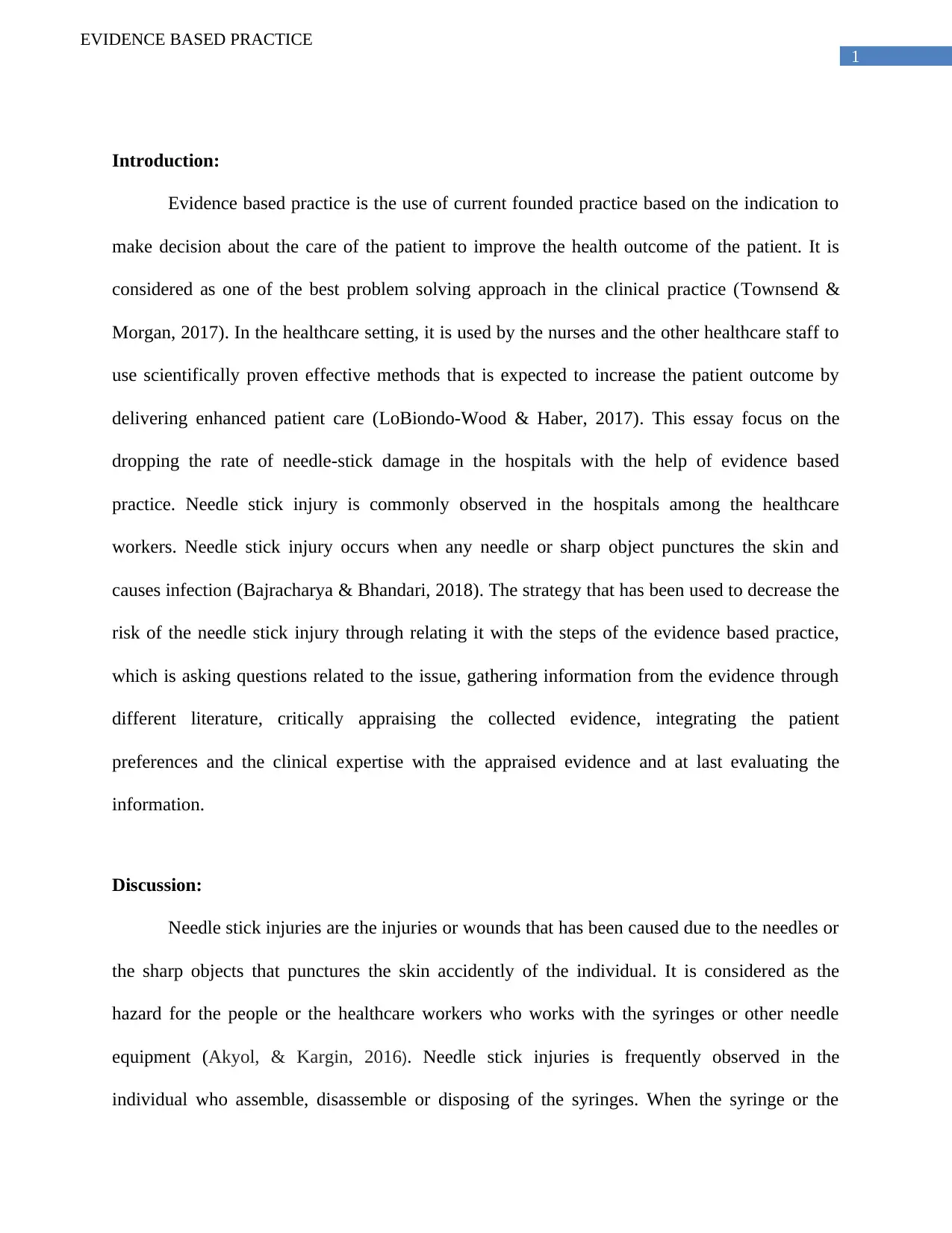
1
EVIDENCE BASED PRACTICE
Introduction:
Evidence based practice is the use of current founded practice based on the indication to
make decision about the care of the patient to improve the health outcome of the patient. It is
considered as one of the best problem solving approach in the clinical practice (Townsend &
Morgan, 2017). In the healthcare setting, it is used by the nurses and the other healthcare staff to
use scientifically proven effective methods that is expected to increase the patient outcome by
delivering enhanced patient care (LoBiondo-Wood & Haber, 2017). This essay focus on the
dropping the rate of needle-stick damage in the hospitals with the help of evidence based
practice. Needle stick injury is commonly observed in the hospitals among the healthcare
workers. Needle stick injury occurs when any needle or sharp object punctures the skin and
causes infection (Bajracharya & Bhandari, 2018). The strategy that has been used to decrease the
risk of the needle stick injury through relating it with the steps of the evidence based practice,
which is asking questions related to the issue, gathering information from the evidence through
different literature, critically appraising the collected evidence, integrating the patient
preferences and the clinical expertise with the appraised evidence and at last evaluating the
information.
Discussion:
Needle stick injuries are the injuries or wounds that has been caused due to the needles or
the sharp objects that punctures the skin accidently of the individual. It is considered as the
hazard for the people or the healthcare workers who works with the syringes or other needle
equipment (Akyol, & Kargin, 2016). Needle stick injuries is frequently observed in the
individual who assemble, disassemble or disposing of the syringes. When the syringe or the
EVIDENCE BASED PRACTICE
Introduction:
Evidence based practice is the use of current founded practice based on the indication to
make decision about the care of the patient to improve the health outcome of the patient. It is
considered as one of the best problem solving approach in the clinical practice (Townsend &
Morgan, 2017). In the healthcare setting, it is used by the nurses and the other healthcare staff to
use scientifically proven effective methods that is expected to increase the patient outcome by
delivering enhanced patient care (LoBiondo-Wood & Haber, 2017). This essay focus on the
dropping the rate of needle-stick damage in the hospitals with the help of evidence based
practice. Needle stick injury is commonly observed in the hospitals among the healthcare
workers. Needle stick injury occurs when any needle or sharp object punctures the skin and
causes infection (Bajracharya & Bhandari, 2018). The strategy that has been used to decrease the
risk of the needle stick injury through relating it with the steps of the evidence based practice,
which is asking questions related to the issue, gathering information from the evidence through
different literature, critically appraising the collected evidence, integrating the patient
preferences and the clinical expertise with the appraised evidence and at last evaluating the
information.
Discussion:
Needle stick injuries are the injuries or wounds that has been caused due to the needles or
the sharp objects that punctures the skin accidently of the individual. It is considered as the
hazard for the people or the healthcare workers who works with the syringes or other needle
equipment (Akyol, & Kargin, 2016). Needle stick injuries is frequently observed in the
individual who assemble, disassemble or disposing of the syringes. When the syringe or the
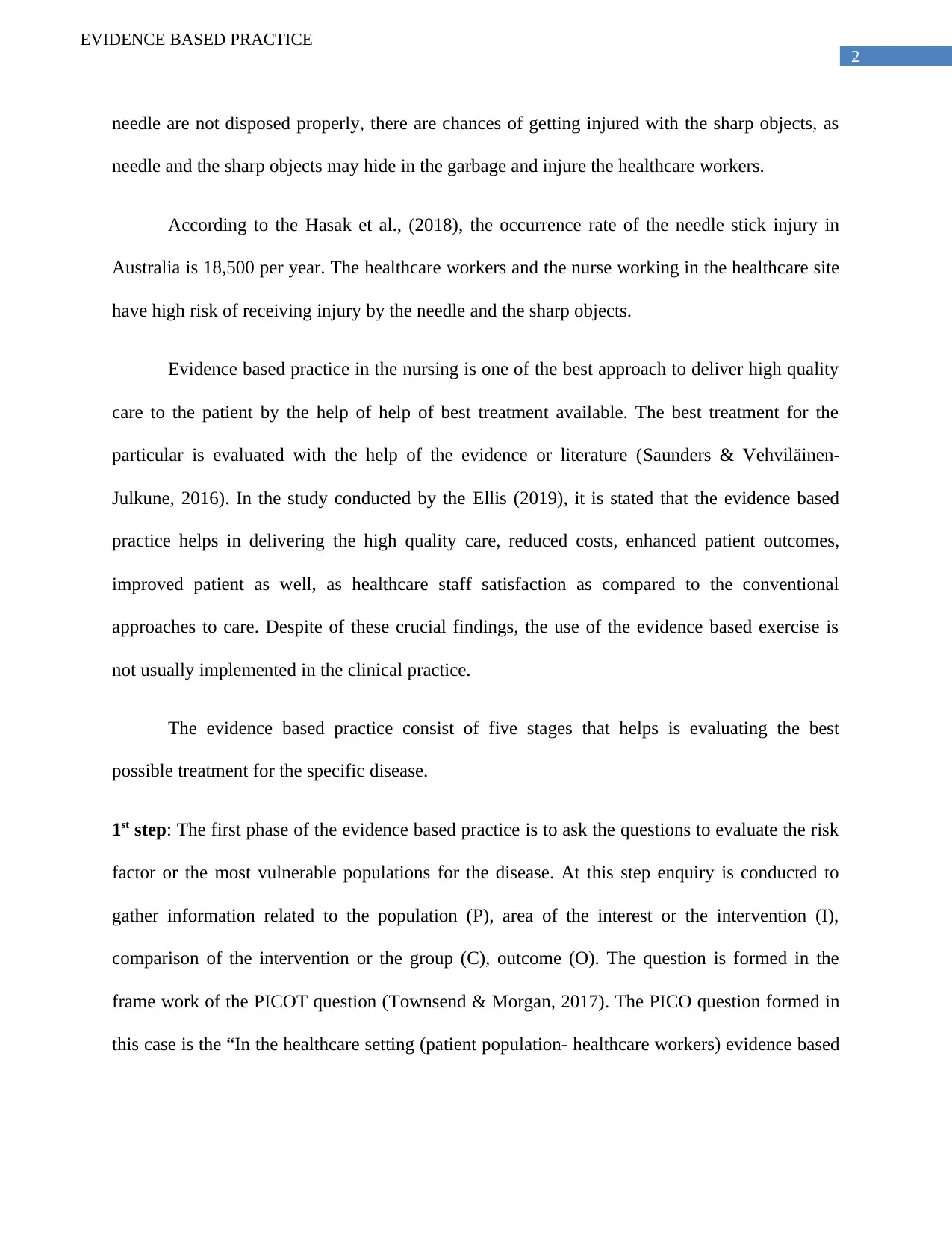
2
EVIDENCE BASED PRACTICE
needle are not disposed properly, there are chances of getting injured with the sharp objects, as
needle and the sharp objects may hide in the garbage and injure the healthcare workers.
According to the Hasak et al., (2018), the occurrence rate of the needle stick injury in
Australia is 18,500 per year. The healthcare workers and the nurse working in the healthcare site
have high risk of receiving injury by the needle and the sharp objects.
Evidence based practice in the nursing is one of the best approach to deliver high quality
care to the patient by the help of help of best treatment available. The best treatment for the
particular is evaluated with the help of the evidence or literature (Saunders & Vehviläinen-
Julkune, 2016). In the study conducted by the Ellis (2019), it is stated that the evidence based
practice helps in delivering the high quality care, reduced costs, enhanced patient outcomes,
improved patient as well, as healthcare staff satisfaction as compared to the conventional
approaches to care. Despite of these crucial findings, the use of the evidence based exercise is
not usually implemented in the clinical practice.
The evidence based practice consist of five stages that helps is evaluating the best
possible treatment for the specific disease.
1st step: The first phase of the evidence based practice is to ask the questions to evaluate the risk
factor or the most vulnerable populations for the disease. At this step enquiry is conducted to
gather information related to the population (P), area of the interest or the intervention (I),
comparison of the intervention or the group (C), outcome (O). The question is formed in the
frame work of the PICOT question (Townsend & Morgan, 2017). The PICO question formed in
this case is the “In the healthcare setting (patient population- healthcare workers) evidence based
EVIDENCE BASED PRACTICE
needle are not disposed properly, there are chances of getting injured with the sharp objects, as
needle and the sharp objects may hide in the garbage and injure the healthcare workers.
According to the Hasak et al., (2018), the occurrence rate of the needle stick injury in
Australia is 18,500 per year. The healthcare workers and the nurse working in the healthcare site
have high risk of receiving injury by the needle and the sharp objects.
Evidence based practice in the nursing is one of the best approach to deliver high quality
care to the patient by the help of help of best treatment available. The best treatment for the
particular is evaluated with the help of the evidence or literature (Saunders & Vehviläinen-
Julkune, 2016). In the study conducted by the Ellis (2019), it is stated that the evidence based
practice helps in delivering the high quality care, reduced costs, enhanced patient outcomes,
improved patient as well, as healthcare staff satisfaction as compared to the conventional
approaches to care. Despite of these crucial findings, the use of the evidence based exercise is
not usually implemented in the clinical practice.
The evidence based practice consist of five stages that helps is evaluating the best
possible treatment for the specific disease.
1st step: The first phase of the evidence based practice is to ask the questions to evaluate the risk
factor or the most vulnerable populations for the disease. At this step enquiry is conducted to
gather information related to the population (P), area of the interest or the intervention (I),
comparison of the intervention or the group (C), outcome (O). The question is formed in the
frame work of the PICOT question (Townsend & Morgan, 2017). The PICO question formed in
this case is the “In the healthcare setting (patient population- healthcare workers) evidence based
⊘ This is a preview!⊘
Do you want full access?
Subscribe today to unlock all pages.

Trusted by 1+ million students worldwide
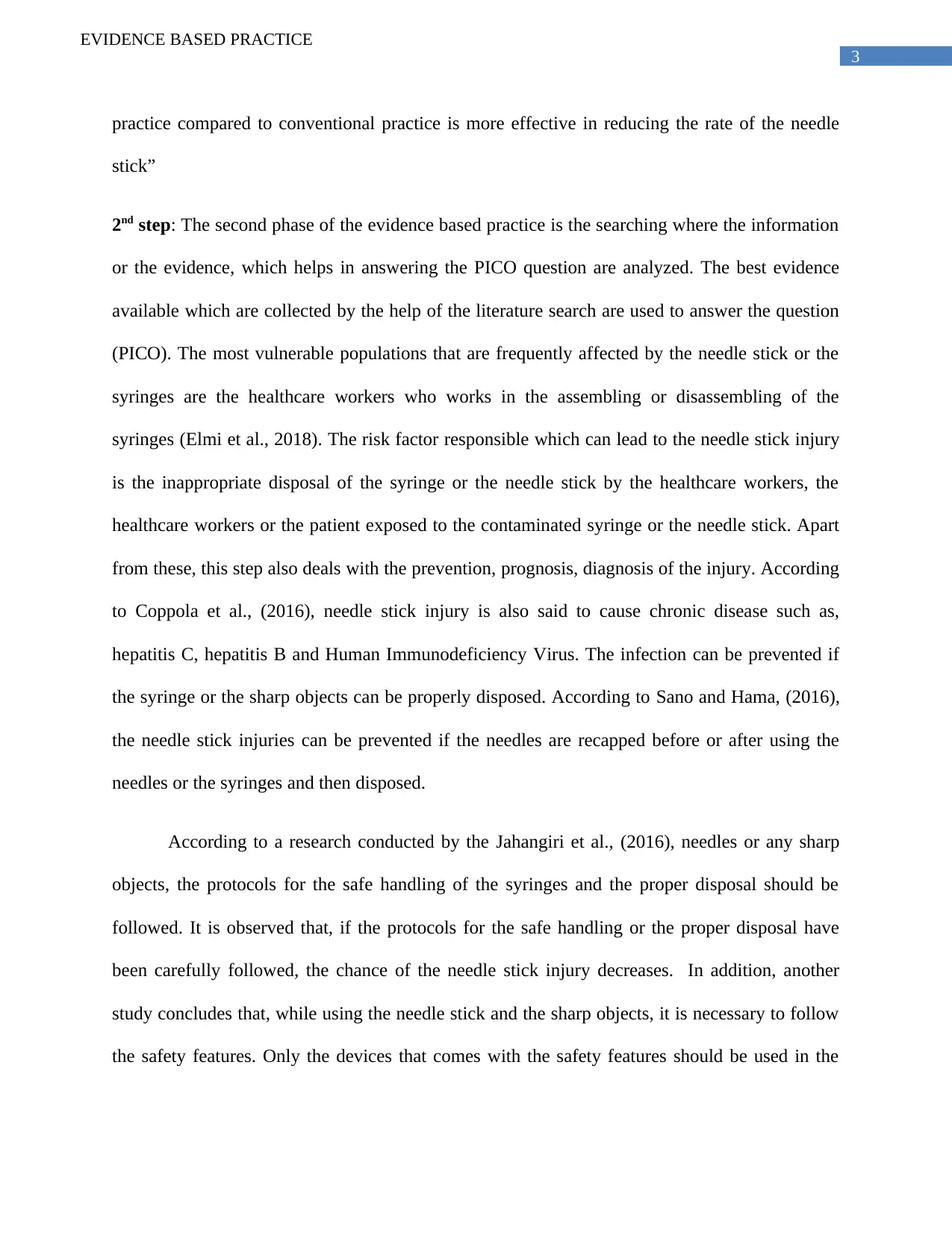
3
EVIDENCE BASED PRACTICE
practice compared to conventional practice is more effective in reducing the rate of the needle
stick”
2nd step: The second phase of the evidence based practice is the searching where the information
or the evidence, which helps in answering the PICO question are analyzed. The best evidence
available which are collected by the help of the literature search are used to answer the question
(PICO). The most vulnerable populations that are frequently affected by the needle stick or the
syringes are the healthcare workers who works in the assembling or disassembling of the
syringes (Elmi et al., 2018). The risk factor responsible which can lead to the needle stick injury
is the inappropriate disposal of the syringe or the needle stick by the healthcare workers, the
healthcare workers or the patient exposed to the contaminated syringe or the needle stick. Apart
from these, this step also deals with the prevention, prognosis, diagnosis of the injury. According
to Coppola et al., (2016), needle stick injury is also said to cause chronic disease such as,
hepatitis C, hepatitis B and Human Immunodeficiency Virus. The infection can be prevented if
the syringe or the sharp objects can be properly disposed. According to Sano and Hama, (2016),
the needle stick injuries can be prevented if the needles are recapped before or after using the
needles or the syringes and then disposed.
According to a research conducted by the Jahangiri et al., (2016), needles or any sharp
objects, the protocols for the safe handling of the syringes and the proper disposal should be
followed. It is observed that, if the protocols for the safe handling or the proper disposal have
been carefully followed, the chance of the needle stick injury decreases. In addition, another
study concludes that, while using the needle stick and the sharp objects, it is necessary to follow
the safety features. Only the devices that comes with the safety features should be used in the
EVIDENCE BASED PRACTICE
practice compared to conventional practice is more effective in reducing the rate of the needle
stick”
2nd step: The second phase of the evidence based practice is the searching where the information
or the evidence, which helps in answering the PICO question are analyzed. The best evidence
available which are collected by the help of the literature search are used to answer the question
(PICO). The most vulnerable populations that are frequently affected by the needle stick or the
syringes are the healthcare workers who works in the assembling or disassembling of the
syringes (Elmi et al., 2018). The risk factor responsible which can lead to the needle stick injury
is the inappropriate disposal of the syringe or the needle stick by the healthcare workers, the
healthcare workers or the patient exposed to the contaminated syringe or the needle stick. Apart
from these, this step also deals with the prevention, prognosis, diagnosis of the injury. According
to Coppola et al., (2016), needle stick injury is also said to cause chronic disease such as,
hepatitis C, hepatitis B and Human Immunodeficiency Virus. The infection can be prevented if
the syringe or the sharp objects can be properly disposed. According to Sano and Hama, (2016),
the needle stick injuries can be prevented if the needles are recapped before or after using the
needles or the syringes and then disposed.
According to a research conducted by the Jahangiri et al., (2016), needles or any sharp
objects, the protocols for the safe handling of the syringes and the proper disposal should be
followed. It is observed that, if the protocols for the safe handling or the proper disposal have
been carefully followed, the chance of the needle stick injury decreases. In addition, another
study concludes that, while using the needle stick and the sharp objects, it is necessary to follow
the safety features. Only the devices that comes with the safety features should be used in the
Paraphrase This Document
Need a fresh take? Get an instant paraphrase of this document with our AI Paraphraser
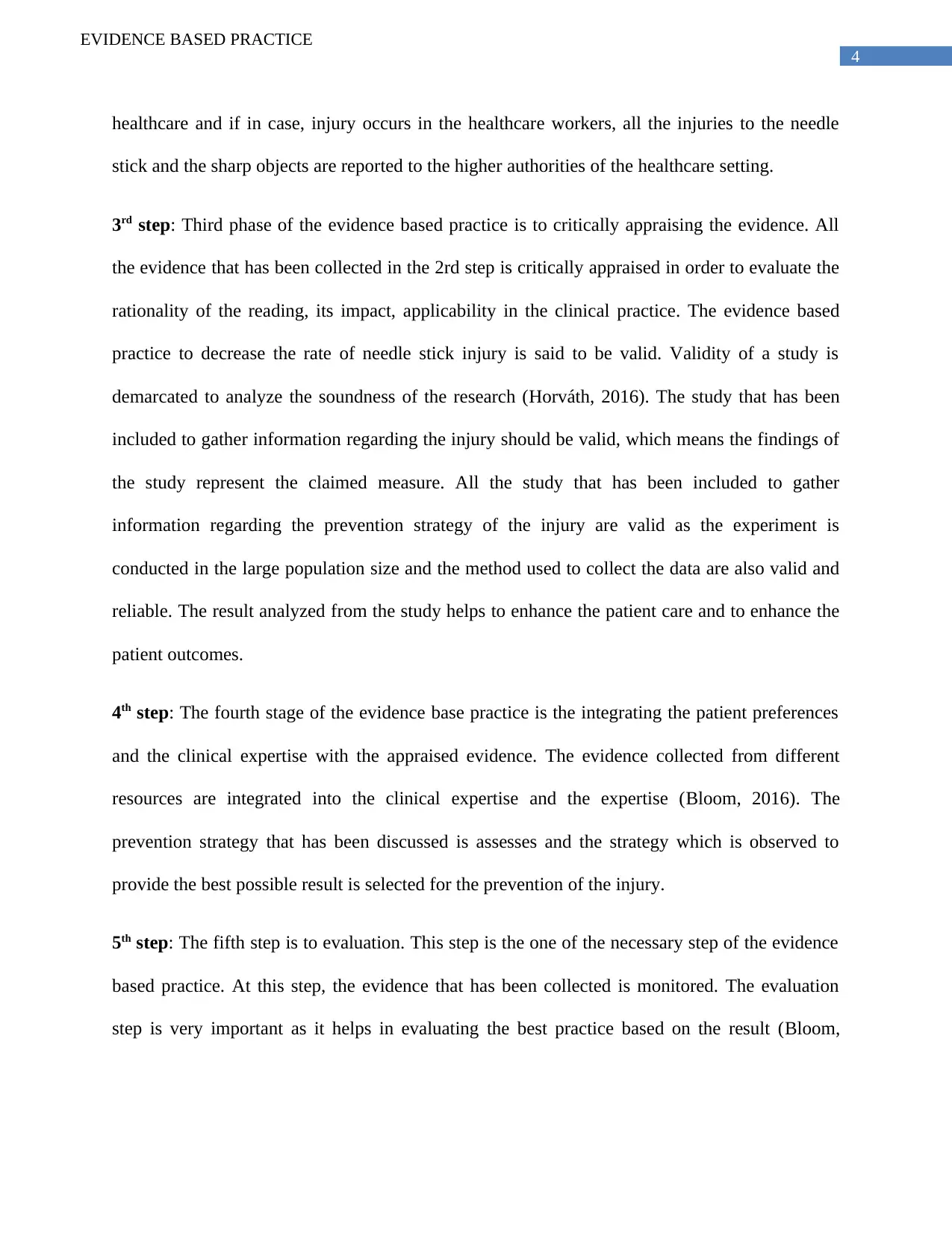
4
EVIDENCE BASED PRACTICE
healthcare and if in case, injury occurs in the healthcare workers, all the injuries to the needle
stick and the sharp objects are reported to the higher authorities of the healthcare setting.
3rd step: Third phase of the evidence based practice is to critically appraising the evidence. All
the evidence that has been collected in the 2rd step is critically appraised in order to evaluate the
rationality of the reading, its impact, applicability in the clinical practice. The evidence based
practice to decrease the rate of needle stick injury is said to be valid. Validity of a study is
demarcated to analyze the soundness of the research (Horváth, 2016). The study that has been
included to gather information regarding the injury should be valid, which means the findings of
the study represent the claimed measure. All the study that has been included to gather
information regarding the prevention strategy of the injury are valid as the experiment is
conducted in the large population size and the method used to collect the data are also valid and
reliable. The result analyzed from the study helps to enhance the patient care and to enhance the
patient outcomes.
4th step: The fourth stage of the evidence base practice is the integrating the patient preferences
and the clinical expertise with the appraised evidence. The evidence collected from different
resources are integrated into the clinical expertise and the expertise (Bloom, 2016). The
prevention strategy that has been discussed is assesses and the strategy which is observed to
provide the best possible result is selected for the prevention of the injury.
5th step: The fifth step is to evaluation. This step is the one of the necessary step of the evidence
based practice. At this step, the evidence that has been collected is monitored. The evaluation
step is very important as it helps in evaluating the best practice based on the result (Bloom,
EVIDENCE BASED PRACTICE
healthcare and if in case, injury occurs in the healthcare workers, all the injuries to the needle
stick and the sharp objects are reported to the higher authorities of the healthcare setting.
3rd step: Third phase of the evidence based practice is to critically appraising the evidence. All
the evidence that has been collected in the 2rd step is critically appraised in order to evaluate the
rationality of the reading, its impact, applicability in the clinical practice. The evidence based
practice to decrease the rate of needle stick injury is said to be valid. Validity of a study is
demarcated to analyze the soundness of the research (Horváth, 2016). The study that has been
included to gather information regarding the injury should be valid, which means the findings of
the study represent the claimed measure. All the study that has been included to gather
information regarding the prevention strategy of the injury are valid as the experiment is
conducted in the large population size and the method used to collect the data are also valid and
reliable. The result analyzed from the study helps to enhance the patient care and to enhance the
patient outcomes.
4th step: The fourth stage of the evidence base practice is the integrating the patient preferences
and the clinical expertise with the appraised evidence. The evidence collected from different
resources are integrated into the clinical expertise and the expertise (Bloom, 2016). The
prevention strategy that has been discussed is assesses and the strategy which is observed to
provide the best possible result is selected for the prevention of the injury.
5th step: The fifth step is to evaluation. This step is the one of the necessary step of the evidence
based practice. At this step, the evidence that has been collected is monitored. The evaluation
step is very important as it helps in evaluating the best practice based on the result (Bloom,
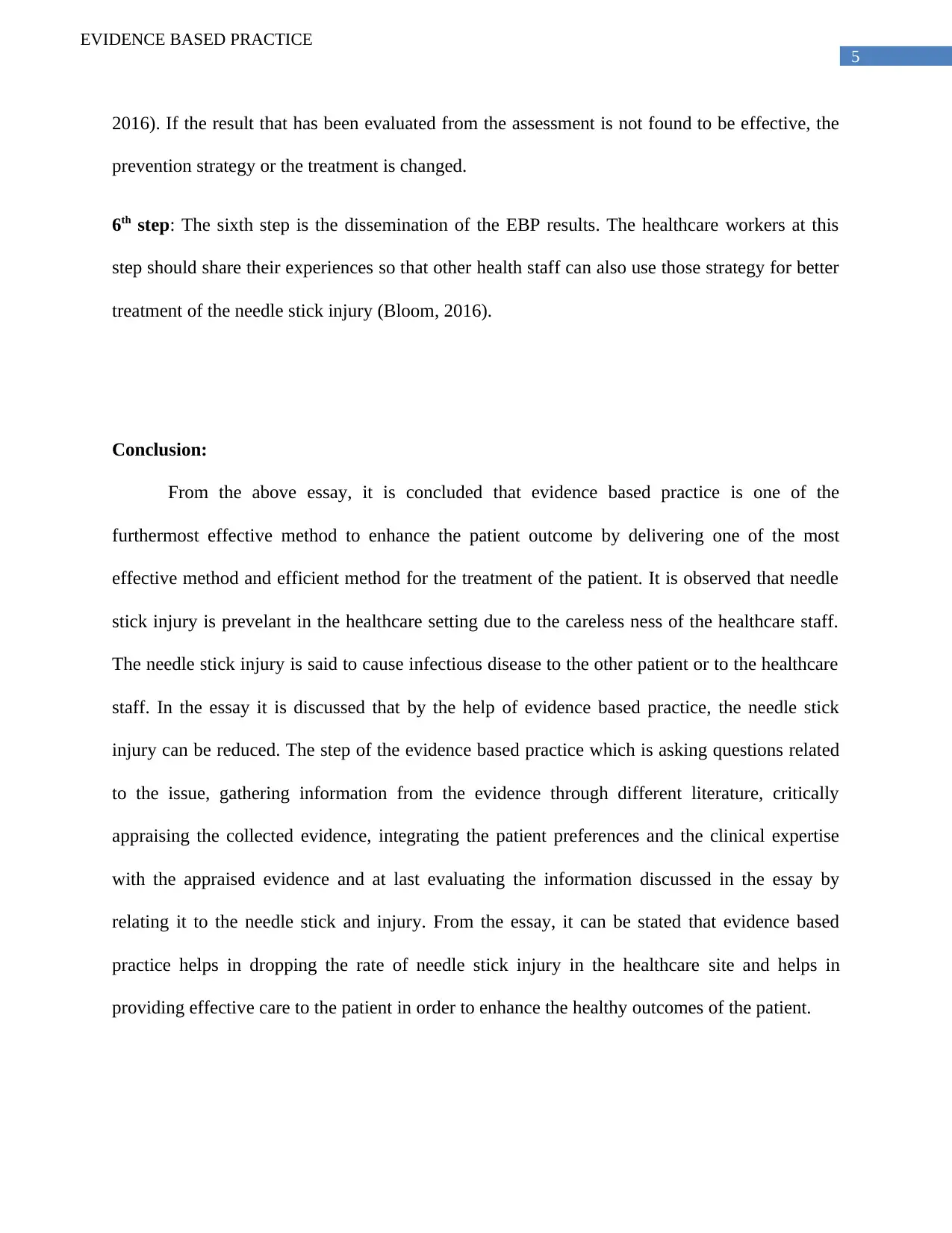
5
EVIDENCE BASED PRACTICE
2016). If the result that has been evaluated from the assessment is not found to be effective, the
prevention strategy or the treatment is changed.
6th step: The sixth step is the dissemination of the EBP results. The healthcare workers at this
step should share their experiences so that other health staff can also use those strategy for better
treatment of the needle stick injury (Bloom, 2016).
Conclusion:
From the above essay, it is concluded that evidence based practice is one of the
furthermost effective method to enhance the patient outcome by delivering one of the most
effective method and efficient method for the treatment of the patient. It is observed that needle
stick injury is prevelant in the healthcare setting due to the careless ness of the healthcare staff.
The needle stick injury is said to cause infectious disease to the other patient or to the healthcare
staff. In the essay it is discussed that by the help of evidence based practice, the needle stick
injury can be reduced. The step of the evidence based practice which is asking questions related
to the issue, gathering information from the evidence through different literature, critically
appraising the collected evidence, integrating the patient preferences and the clinical expertise
with the appraised evidence and at last evaluating the information discussed in the essay by
relating it to the needle stick and injury. From the essay, it can be stated that evidence based
practice helps in dropping the rate of needle stick injury in the healthcare site and helps in
providing effective care to the patient in order to enhance the healthy outcomes of the patient.
EVIDENCE BASED PRACTICE
2016). If the result that has been evaluated from the assessment is not found to be effective, the
prevention strategy or the treatment is changed.
6th step: The sixth step is the dissemination of the EBP results. The healthcare workers at this
step should share their experiences so that other health staff can also use those strategy for better
treatment of the needle stick injury (Bloom, 2016).
Conclusion:
From the above essay, it is concluded that evidence based practice is one of the
furthermost effective method to enhance the patient outcome by delivering one of the most
effective method and efficient method for the treatment of the patient. It is observed that needle
stick injury is prevelant in the healthcare setting due to the careless ness of the healthcare staff.
The needle stick injury is said to cause infectious disease to the other patient or to the healthcare
staff. In the essay it is discussed that by the help of evidence based practice, the needle stick
injury can be reduced. The step of the evidence based practice which is asking questions related
to the issue, gathering information from the evidence through different literature, critically
appraising the collected evidence, integrating the patient preferences and the clinical expertise
with the appraised evidence and at last evaluating the information discussed in the essay by
relating it to the needle stick and injury. From the essay, it can be stated that evidence based
practice helps in dropping the rate of needle stick injury in the healthcare site and helps in
providing effective care to the patient in order to enhance the healthy outcomes of the patient.
⊘ This is a preview!⊘
Do you want full access?
Subscribe today to unlock all pages.

Trusted by 1+ million students worldwide
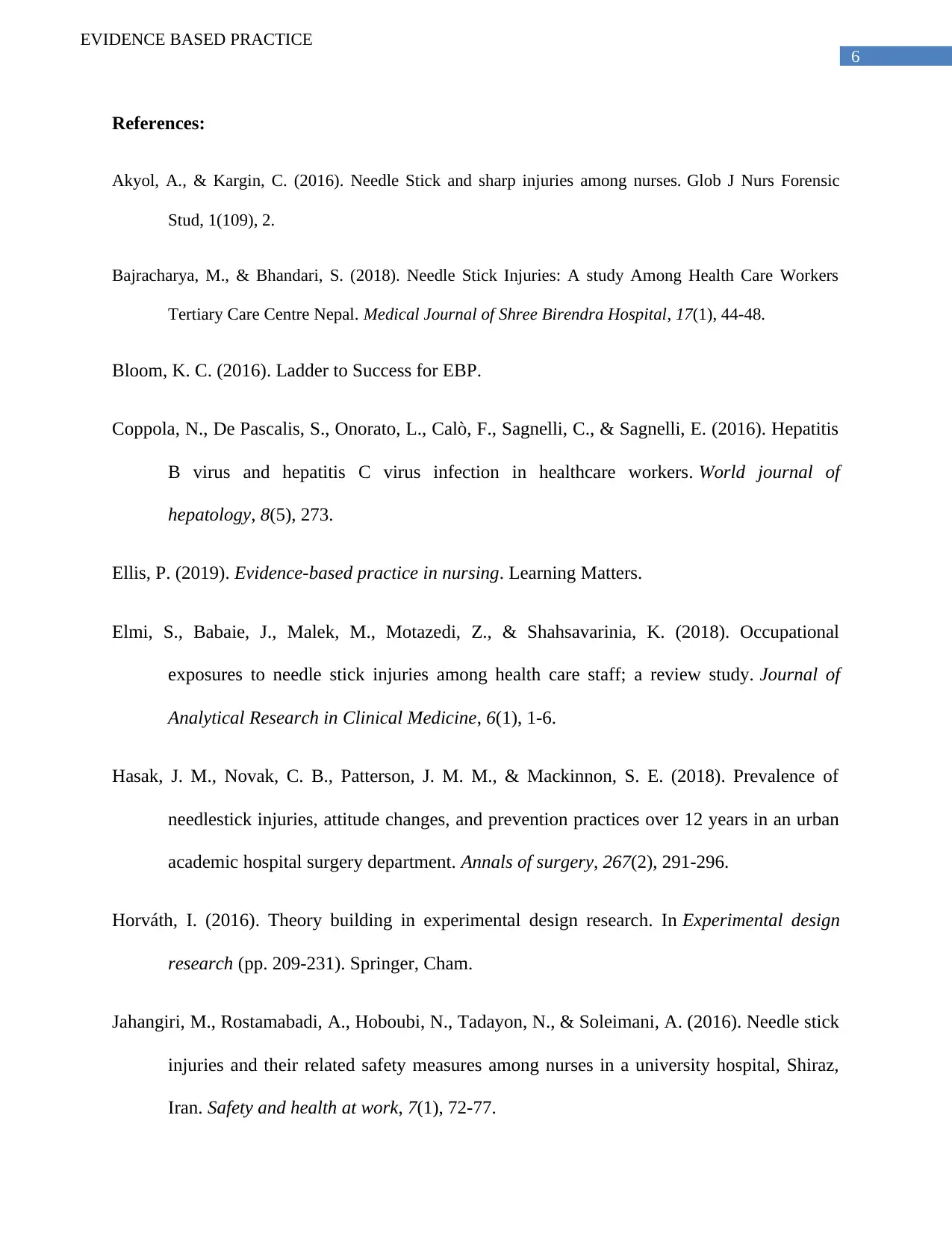
6
EVIDENCE BASED PRACTICE
References:
Akyol, A., & Kargin, C. (2016). Needle Stick and sharp injuries among nurses. Glob J Nurs Forensic
Stud, 1(109), 2.
Bajracharya, M., & Bhandari, S. (2018). Needle Stick Injuries: A study Among Health Care Workers
Tertiary Care Centre Nepal. Medical Journal of Shree Birendra Hospital, 17(1), 44-48.
Bloom, K. C. (2016). Ladder to Success for EBP.
Coppola, N., De Pascalis, S., Onorato, L., Calò, F., Sagnelli, C., & Sagnelli, E. (2016). Hepatitis
B virus and hepatitis C virus infection in healthcare workers. World journal of
hepatology, 8(5), 273.
Ellis, P. (2019). Evidence-based practice in nursing. Learning Matters.
Elmi, S., Babaie, J., Malek, M., Motazedi, Z., & Shahsavarinia, K. (2018). Occupational
exposures to needle stick injuries among health care staff; a review study. Journal of
Analytical Research in Clinical Medicine, 6(1), 1-6.
Hasak, J. M., Novak, C. B., Patterson, J. M. M., & Mackinnon, S. E. (2018). Prevalence of
needlestick injuries, attitude changes, and prevention practices over 12 years in an urban
academic hospital surgery department. Annals of surgery, 267(2), 291-296.
Horváth, I. (2016). Theory building in experimental design research. In Experimental design
research (pp. 209-231). Springer, Cham.
Jahangiri, M., Rostamabadi, A., Hoboubi, N., Tadayon, N., & Soleimani, A. (2016). Needle stick
injuries and their related safety measures among nurses in a university hospital, Shiraz,
Iran. Safety and health at work, 7(1), 72-77.
EVIDENCE BASED PRACTICE
References:
Akyol, A., & Kargin, C. (2016). Needle Stick and sharp injuries among nurses. Glob J Nurs Forensic
Stud, 1(109), 2.
Bajracharya, M., & Bhandari, S. (2018). Needle Stick Injuries: A study Among Health Care Workers
Tertiary Care Centre Nepal. Medical Journal of Shree Birendra Hospital, 17(1), 44-48.
Bloom, K. C. (2016). Ladder to Success for EBP.
Coppola, N., De Pascalis, S., Onorato, L., Calò, F., Sagnelli, C., & Sagnelli, E. (2016). Hepatitis
B virus and hepatitis C virus infection in healthcare workers. World journal of
hepatology, 8(5), 273.
Ellis, P. (2019). Evidence-based practice in nursing. Learning Matters.
Elmi, S., Babaie, J., Malek, M., Motazedi, Z., & Shahsavarinia, K. (2018). Occupational
exposures to needle stick injuries among health care staff; a review study. Journal of
Analytical Research in Clinical Medicine, 6(1), 1-6.
Hasak, J. M., Novak, C. B., Patterson, J. M. M., & Mackinnon, S. E. (2018). Prevalence of
needlestick injuries, attitude changes, and prevention practices over 12 years in an urban
academic hospital surgery department. Annals of surgery, 267(2), 291-296.
Horváth, I. (2016). Theory building in experimental design research. In Experimental design
research (pp. 209-231). Springer, Cham.
Jahangiri, M., Rostamabadi, A., Hoboubi, N., Tadayon, N., & Soleimani, A. (2016). Needle stick
injuries and their related safety measures among nurses in a university hospital, Shiraz,
Iran. Safety and health at work, 7(1), 72-77.
Paraphrase This Document
Need a fresh take? Get an instant paraphrase of this document with our AI Paraphraser
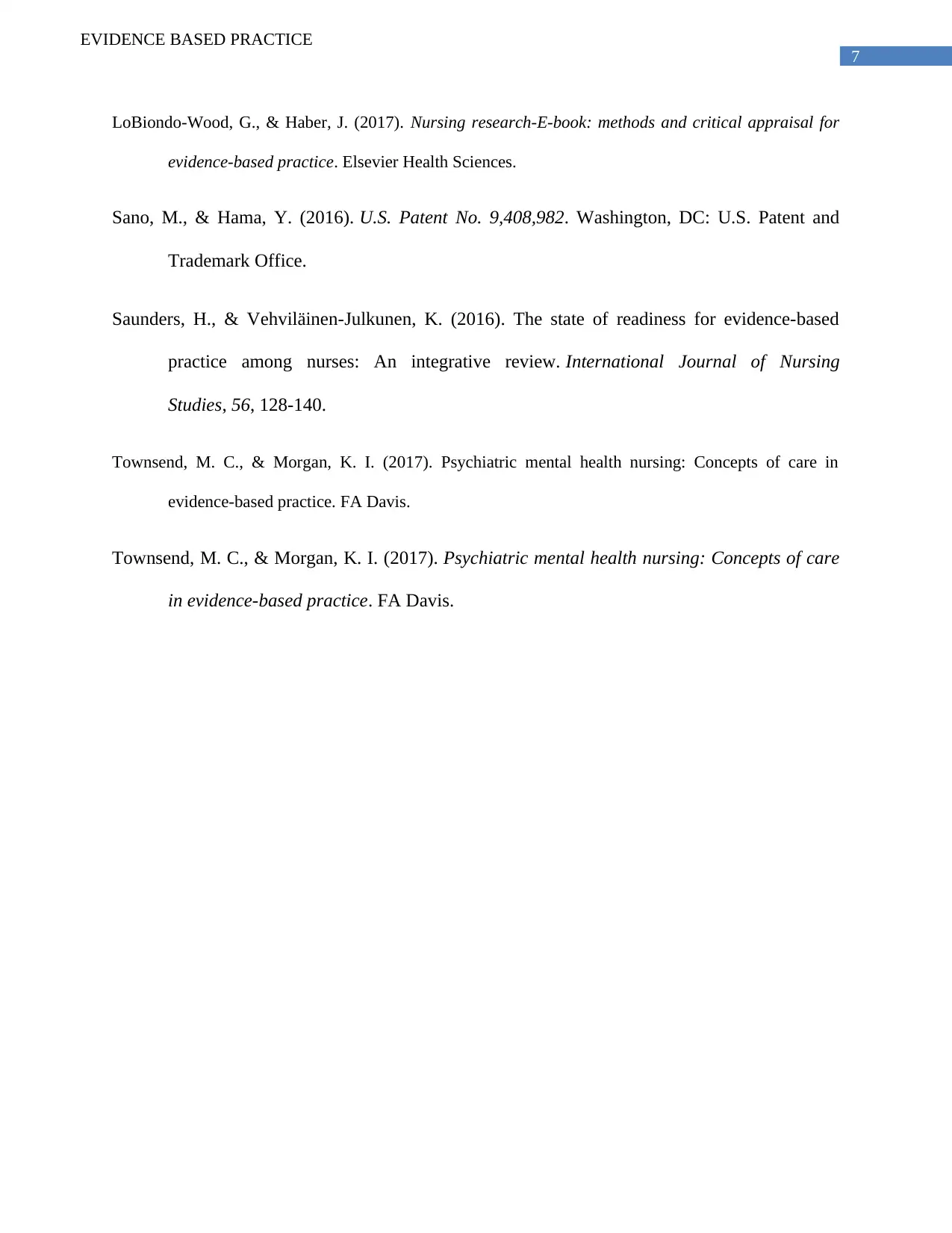
7
EVIDENCE BASED PRACTICE
LoBiondo-Wood, G., & Haber, J. (2017). Nursing research-E-book: methods and critical appraisal for
evidence-based practice. Elsevier Health Sciences.
Sano, M., & Hama, Y. (2016). U.S. Patent No. 9,408,982. Washington, DC: U.S. Patent and
Trademark Office.
Saunders, H., & Vehviläinen-Julkunen, K. (2016). The state of readiness for evidence-based
practice among nurses: An integrative review. International Journal of Nursing
Studies, 56, 128-140.
Townsend, M. C., & Morgan, K. I. (2017). Psychiatric mental health nursing: Concepts of care in
evidence-based practice. FA Davis.
Townsend, M. C., & Morgan, K. I. (2017). Psychiatric mental health nursing: Concepts of care
in evidence-based practice. FA Davis.
EVIDENCE BASED PRACTICE
LoBiondo-Wood, G., & Haber, J. (2017). Nursing research-E-book: methods and critical appraisal for
evidence-based practice. Elsevier Health Sciences.
Sano, M., & Hama, Y. (2016). U.S. Patent No. 9,408,982. Washington, DC: U.S. Patent and
Trademark Office.
Saunders, H., & Vehviläinen-Julkunen, K. (2016). The state of readiness for evidence-based
practice among nurses: An integrative review. International Journal of Nursing
Studies, 56, 128-140.
Townsend, M. C., & Morgan, K. I. (2017). Psychiatric mental health nursing: Concepts of care in
evidence-based practice. FA Davis.
Townsend, M. C., & Morgan, K. I. (2017). Psychiatric mental health nursing: Concepts of care
in evidence-based practice. FA Davis.
1 out of 8
Related Documents
Your All-in-One AI-Powered Toolkit for Academic Success.
+13062052269
info@desklib.com
Available 24*7 on WhatsApp / Email
![[object Object]](/_next/static/media/star-bottom.7253800d.svg)
Unlock your academic potential
Copyright © 2020–2025 A2Z Services. All Rights Reserved. Developed and managed by ZUCOL.





